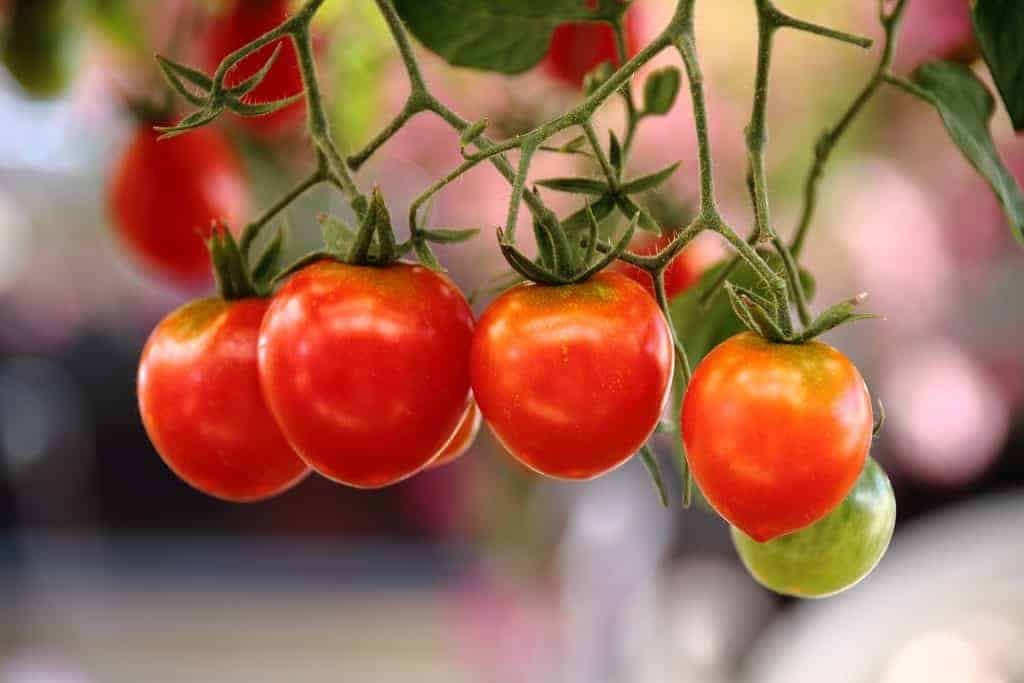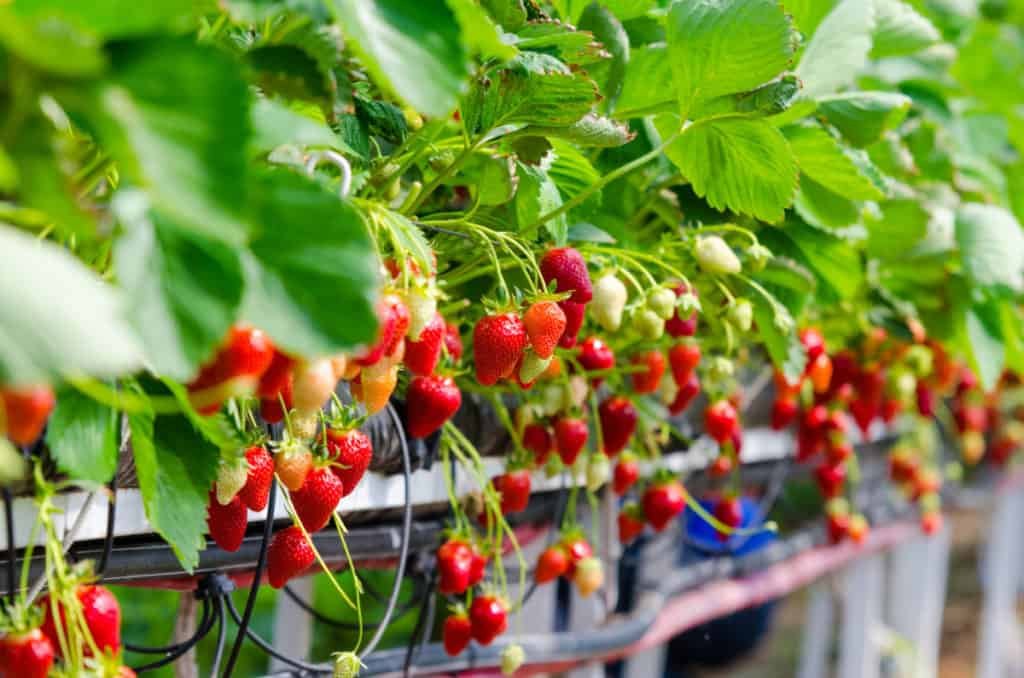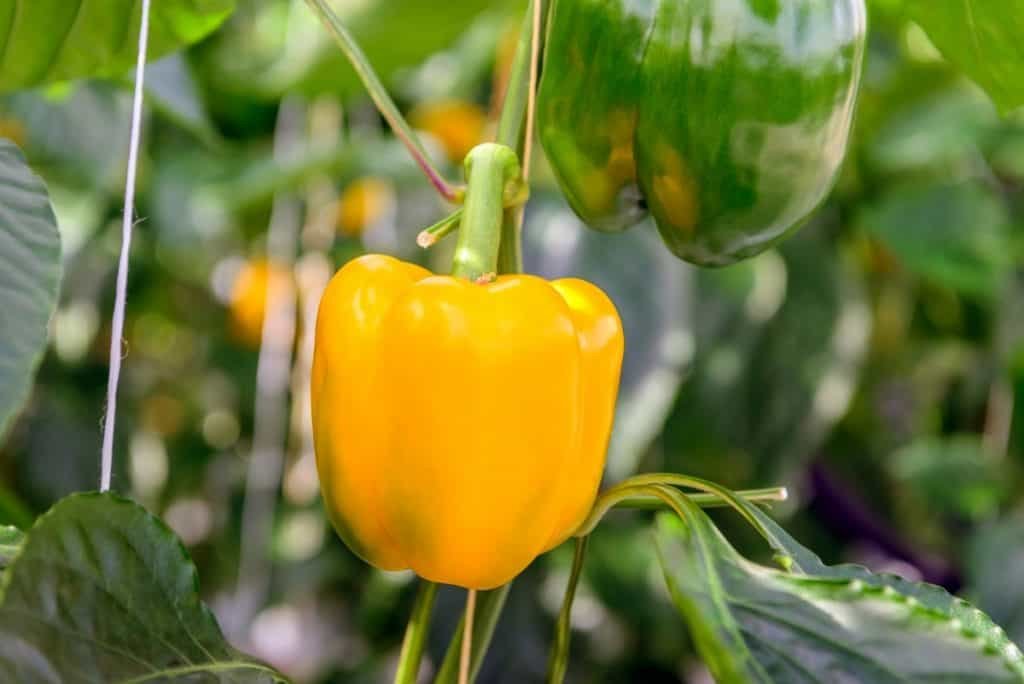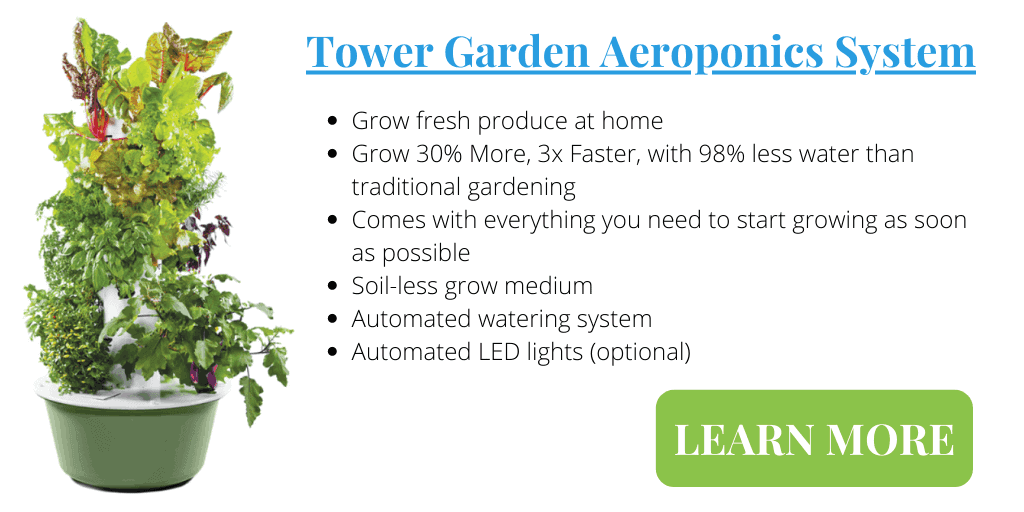You may be surprised by the wide variety of edible plants you can grow with an aeroponics system. Growing many fruits, vegetables, legumes, and more can be grown either indoor or outdoor using a well designed aeroponics setup. We’ll first go over some of the best crops to grow in an aeroponics system, and finally, send you off with our top two recommendations for awesome aeroponic gardening harvests.
Because so many different varieties of plants grow well using the aeroponic growing method, it provides a great solution for individuals, families and commercial growers to produce healthy and delicious fruits and vegetables. This can all be done in small spaces with less water, less fertilizer, fewer pest issues and requires no bending down or digging while producing higher yields than traditional gardening.
A Quick Introduction to Aeroponics
Aeroponics is the name for a method of growing plants and crops without the use of soil. The plant’s roots are suspended in air in a semi-sealed chamber creating a humid, oxygen rich environment. A nutrient-infused mineral solution is provided directly to the roots which provide the plant with all the necessary components it needs for healthy growth.
Aeroponic systems can be high pressure which provides the nutrient solution as a mist, or low pressure which drips or pours the solution over the roots. Both systems require a water pump, a reservoir to hold the nutrient solution, a chamber for the roots and electricity.
Aeroponics is a sustainable way to grow and produce large harvests in small spaces with little waste or work. Learn more about aeroponics in my article, How does Aeroponics work.
Cucumbers
Cucumbers are a staple of hydroponic gardening that also grow extremely well in aeroponic systems. Cucumber plants are vining plants, so you’ll want to make sure you set up your aeroponic system with lots of vertical space for vertical growth.
Use a trellis or a similar structure to allow your cucumber vines to climb and give them lots of space to grow. Proper trimming and pruning can help control the plant size while also increasing the yield it provides.
There are lots of different varieties of cucumber that will all grow well in aeroponic systems from large field cucumbers to smaller pickling varieties. Your aeroponic garden will bring the added benefit of allowing you to grow varieties that might not typically grow well in your grow zone and enjoy them all year round.
Tomatoes
Tomatoes are available in both vining and bushing varieties. Much like cucumbers, the vining plants need lots of vertical space to grow. The size, shape and production of tomato plants is easy to control using simple pruning techniques and they’re packed with vitamins and delicious flavor.
When growing tomatoes vertically you will need to consider spacing requirements. Learn more in my article, How Close Can You Plant Tomatoes Vertically? If you are planning to plant cucumbers in your aeroponics system, you are probably also setting yourself up to successfully grow tomatoes.
Smaller, cherry or grape tomatoes are a favorite and the added benefits of aeroponics systems will ensure that any variety of tomato you grow will produce lots of fruit. Growing different heirloom tomato varieties in your aeroponics systems will stagger your harvests, give you more meal options and provide healthy fresh tomatoes all year round.

Brussels Sprouts
Anyone who has seen brussels sprouts growing can’t help but be in awe of this massive plant. Brussels sprouts grow extremely well in tower gardens and other aeroponics systems, but they come with a catch.
The leaves of brussels sprout plants get huge, so it is important to consider the spacing necessary to give your sprouts room to grow. Also, when planting multiple crops in a tower garden, the leaves of brussels sprouts could shade out other plants. Plant brussels sprouts low on the tower to avoid their leaves blocking the sunlight from reaching other crops.
Bulb Fennel
Bulb fennel has lots of culinary uses. You can cook the bulbs and, if you let it produce seeds, you can dry those and use them as a seasoning. The licorice-like taste of bulb fennel makes it a favorite in gourmet kitchens everywhere.
Since bulb fennel grows better in cooler weather, you might plant these in the off-season where you would normally grow other crops. Bulb fennel is a beautiful and flavorful addition to any aeroponics system. The efficiency of aeroponics systems will ensure that your bulb fennel produces large, delicious crops.
Leafy Greens
Lettuce, spinach, kale, mustard greens, collard greens, different varieties of cabbage (like bok choy), and other leafy greens are easy to grow in small spaces with aeroponics systems. Vertical tower systems are popular among aeroponic gardeners as a great way to ensure that you maximize your growing space while giving leafy greens the space they need to grow.
Lettuce plants are extremely sensitive to temperature, so it is a good idea to build your aeroponics systems indoor or in a temperature-controlled area. If lettuces and other leafy greens get too hot, they will go to seed, and the crop will become bitter. When growing them outdoors you’ll want to focus on the spring and fall seasons while avoiding the heat of summer.

Pumpkins and Gourds
Pumpkins and other gourds may not be your first thought to grow in an aeroponic system, but these classic autumn crops can grow very well in aeroponic systems if they receive the proper care. Pumpkins and gourds can get really big, as you know, so make sure to leave a lot of space between plants.
Gourds and pumpkins might not grow well off of vertical gardens but will flourish in single-level aeroponic systems or on the bottom level of a tower. Make sure that you prune your pumpkin or gourd vines regularly.
These plants will take extra water which might dissuade you from trying to grow them in aeroponic systems. After all, aeroponic systems are valued for their ability to recycle most of the water over and over. If you really want to grow gourds and don’t have the ground space, aeroponics is a great solution.
Okra
Okra is a favorite in the South. It can be cooked into stews, gumbos, or pickled and eaten as a healthy snack. Okra usually produces large yields and that will only be increased if you grow them using an aeroponics system.
Okra also grows quickly and can be ready to harvest after only two months. Most varieties of okra, though, have spines on their stalks that can irritate the skin so make sure to wear gloves when pruning or harvesting.
Melons
Melons, like gourds, will take a lot more water from your aeroponics system than other plants but watermelon, cantaloupe, and honeydew are a great summertime treat that can be worth the extra input.
Melons take about the same care as gourds as well. Prune the plants often, give them a lot of space to spread and grow, and make sure that the produce is well-supported so that its weight doesn’t make it fall off its suspended vine.

Strawberries
Strawberries are a staple of hydroponic gardening that can grow just as well in aeroponic systems. No matter how they are grown, fruits can be trickier than lettuces or herbs because you have to maintain the plant through leafy growth, flowering, and fruit growth.
Strawberry plants will grow well with a balanced nutrient mix while the plants and flowers are growing but to produce big, ripe berries you’ll want to switch to a mix that is higher in potassium to help the fruit develop.
A key thing to remember when maintaining strawberries is that they will put out runners to grow new plants. When planting in an aeroponic system, however, those runners won’t be able to take root. Simply snip those runners off and, if you desire, put them in a diluted nutrient solution until they sprout roots and then plant them in your aeroponics system.
Herbs
Herbs are fairly easy to grow in most environments and will flourish under the control afforded by aeroponics systems. Many herbs require very little care and can be harvested year-round. Herbs enjoy a slightly acidic pH and nitrogen-rich mixtures.
Herbs that you might consider growing in your personal aeroponic system include cilantro, thyme, basil, oregano, mint, and parsley to name a few. Fresh herbs pack tons of flavor and if you grow more than you need, you can dry the leaves for use as seasoning.
Lemongrass and wheatgrass, while technically a grass and not a leafy herb, will also flourish in aeroponic systems. Both are easy to grow and will grow well at the top of a vertical tower garden or in a horizontal aeroponic system.
Peas
Varieties of peas, like snow peas or sugar snap peas, are vining plants that produce large quantities of produce. Like other vining plants, it is important to give them lots of space to grow vertically.
When nourishing your aeroponic pea-plants, remember that they don’t like acidic mixes. Many varieties of pea plant have two growing seasons, in the early spring and late fall when the weather is cooler.
Beans
Technically, peas are in the family of bean plants, so it is no secret that many varieties of beans can be grown aeroponically. Garbanzo beans, also known as chickpeas, navy beans, lentils, and other beans will all flourish in your aeroponics system.
Remember, though, that different types of beans need different care to grow and produce so don’t treat all of your beans the same. Research the best nutrient mixes for the kinds of beans you want to grow!

Peppers
Peppers are another vertical growing plant like cucumbers and tomatoes that grow well in aeroponic systems when given the proper space and care. Bell peppers are the most popular of all varieties while cayenne and jalapeno are easy to grow as well.
One trick for maximizing the produce a pepper plant will yield is to pinch off the first flowers that it blooms. This will help the plant direct nutrients and energy into the crops later in the season to increase yield.
Carrots
While it is technically possible to grow almost anything with aeroponics, some crops will present more of a challenge than others. Root crops, like carrots, could grow in aeroponics systems while hydroponic systems usually wouldn’t work for carrots.
Experiment with what works for your aeroponics system. A tower garden system might make it hard to see when your carrots are ready to harvest, and you might want to harvest early because of that. Single level aeroponics systems that allow easy access to the root systems of your crops will let you harvest carrots and other roots crops easily.
Because the root of the carrot is the crop, there is lots of surface area for them to absorb the nutrients from the mineral solution. As with melons and gourds, you might want to harvest carrots and other root crops before they get too big for your aeroponic system to support.
Radishes
Radishes are valued for their uniquely spicy flavor and, as root crops, can flourish in aeroponic systems when they would fail in hydroponic gardens. There are lots of varieties of radishes and you might want to grow a smaller variety to make them easier to harvest.
Radishes grow really quickly, and some can be harvested a month after sprouting, so make sure to pay close attention to when your radishes are ready to be picked. Root crops like radishes and carrots are a great way for brave gardeners to test the limits of aeroponics systems!
Leek
Adventurous gardeners might also try to grow leeks aeroponically. Leeks are in the onion family and while it would be difficult to grow onion bulbs using aeroponics, Leeks are no problem.
Leeks are suited to colder temperatures, so make sure that you will be able to provide them with a cool space to grow, whether outdoors or indoors. Leeks might need more room than other plants in your aeroponic systems as well.

Blueberry
Blueberries can be grown in an aeroponic system year round without issue by staggering the planting to overlap dormant periods. If you want to try to grow aeroponic blueberries, one thing to remember is that they require high acidity and 60-75% humidity.You might need to build or purchase an aeroponic system specifically for your blueberries for those reasons.
The ultra-high acidity that blueberries require probably would kill most other plants. Choose a high quality pump to allow the misters to work overtime to provide the high moisture in which blueberries will flourish.
Ginger
Anyone who has grown ginger knows that it is simple to grow but that patience is key. Ginger is a root crop that will certainly grow aeroponically given the right conditions, but ginger can take a really long time to grow before it is ready to harvest.
The main thing to remember if you want to grow ginger in your aeroponic system is patience. Ginger is beloved for its uniquely spicy flavor and is used as a natural medicine for soothing an upset stomach in many cultures.
A study by the University of Arizona shows that ginger grows best when in a grow medium such as perlite. The same study also suggests that aeroponic ginger cultivation can help to ward off the many soil-borne diseases that plague ginger crops.
Potato
Potatoes, like carrots and other root crops, can be grown aeroponically but might require a unique setup dedicated to this culinary staple. The roots of potato plants get extremely long so the container which houses the roots and mist system has to be quite tall to accommodate potato plants.
Growing potatoes aeroponically can decrease grow time and increase yield because potatoes enjoy lots of oxygen. Gardeners who are dedicated to growing potatoes aeroponically will enjoy the benefits that aeroponic systems can offer for the crop.
Aeroponics Systems for Home
Making an aeroponics system is not overly complicated but it will require some hours of research and building. There will also be free tuition to the school of hard knock getting the system dialed in correctly and throughout the growing process.
For this reason I always suggest purchasing a complete ready-to-go system for your first venture in aeroponics gardening. This takes all the frustration and guess work out of having a successful first attempt and harvest.
Once you have some miles on your system you can choose to build another system from scratch or experiment with changing the operation of your existing system. Either way you decide to go experience is the key to obtaining the best results.

Tower Garden
The Tower Garden is hands down the best ready-to-grow system when it comes to aeroponic gardening systems. The system is a simple to maintain, worry free 20+ plant vertical growing tower.
Growing vertically allows you to get the most efficient use of your square footage while reducing water and fertilizer inputs. I grow tomatoes, cucumbers, peppers, kale, strawberries, peas and many other delicious fruits and vegetables in my tower at home just a couple steps from my kitchen. The yields of the plants are large and the flavors delicious. There’s no substitute for year round fresh produce and it’s an extremely simple and low maintenance system to use.
For more details here’s a link to check out the Tower Garden Aeroponic System for yourself.
Final Thoughts
These are just 19 of the healthy and hearty plants you can grow in your aeroponics system at home. With research, care, and patience, you can live sustainably off fresh plant food grown right in your own home all year round. Aeroponics is the eco-friendly future of harvesting bigger yields with less water and a smaller environmental impact.
